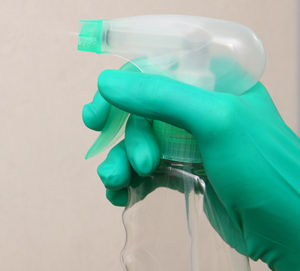When selecting the best surface disinfectants for a dental practice, efficiency and efficacy count.
 From the upholstered chairs in the patient waiting area, to hard metal, plastic and laminate equipment and counter surfaces in the operatory, dental settings can be a haven for bacteria, flu viruses, MRSA and bloodborne pathogens – some which survive on surfaces for days, weeks or months, according to Sarah C. Bell-West, PhD, technical liaison for Clorox Healthcare. “Patients who carry these pathogens may not always show the symptoms, making disinfection a constant priority beyond just the operatory,” she says. In turn, dental professionals require fast-acting, ready-to-use disinfectants, which are compatible with a variety of surfaces, she adds.
From the upholstered chairs in the patient waiting area, to hard metal, plastic and laminate equipment and counter surfaces in the operatory, dental settings can be a haven for bacteria, flu viruses, MRSA and bloodborne pathogens – some which survive on surfaces for days, weeks or months, according to Sarah C. Bell-West, PhD, technical liaison for Clorox Healthcare. “Patients who carry these pathogens may not always show the symptoms, making disinfection a constant priority beyond just the operatory,” she says. In turn, dental professionals require fast-acting, ready-to-use disinfectants, which are compatible with a variety of surfaces, she adds.
“In order to address infection control issues across the entire practice, it is important to select disinfectants that are appropriate for use on a wide variety of surfaces found throughout dental settings, and that have also been optimized for aesthetics, surface compatibility and ease of use, with low-odor profiles and minimal residue formulations,” Bell-West continues. Clorox Healthcare offers a number of such products, some which are designed to kill antibiotic-resistant microorganisms, TB, Hepatitis B, HIV, norovirus, flu viruses and MRSA.
Subhead: Evaluating the products
In a busy dental setting, where both efficacy and efficiency are essential, dental professionals need surface disinfectants that kill priority pathogens, as well as save the practice time. The best way to familiarize themselves with available products is to carefully read product labels, notes Bell-West.
“Every minute counts in a busy dental practice, and dental procedures can easily and quickly contaminate the environment with bodily fluids and pathogens of concern, so it is important that dental teams select one-step cleaner-disinfectants that have demonstrated disinfection efficacy in the presence of soil,” she says. “Distributor representatives should encourage dental teams to review product label instructions, which provide guidance on whether users need to preclean a surface before disinfecting (a two-step product) or whether users can clean and disinfect with one application (a one-step product).”
Another important consideration is a product’s compatibility with surfaces and equipment in the office. Before using new products, the dental team should review product labels and safety data sheets (SDS) “to familiarize themselves with the product chemistry, directions for use and safety information,” says Bell-West. “Some disinfectant ingredients, such as alcohols (i.e., ethanol and isopropanol) are essential for disinfection efficacy, but can damage surfaces like hard plastics and flexible tubing over time.” It is also important to use the proper personal protective equipment (PPE), when appropriate, to ensure safe handling.
Dental professionals should explore the evidence behind product claims, including efficacy data and peer-reviewed studies, Bell-West continues. “Facts about the germ prevalence, cross-contamination and transmission can help dental practices see the value in selecting Environmental Protection Agency (EPA) registered surface disinfectants, which do not force them to make tradeoffs between efficacy and compatibility. Studies suggest that 80 percent of infectious diseases are spread by touch.[i] In one dental practice, researchers recovered MRSA colonies from light switches, computer keyboards and dental chair push buttons over the course of a single day. [ii] Patients and staff members can carry and spread germs without knowing it, and many germs can survive on environmental surfaces for extended periods and be spread to others, making cleaning and disinfection an important daily step to help ensure a safe and healthy dental practice.”
For more information on surface disinfection, or to stay informed on current guidelines, Bell-West recommends visiting the Centers for Disease Control and Prevention (CDC), Occupational Safety and Health Administration (OSHA) and Organization for Safety, Asepsis and Prevention (OSAP) websites:
- CDC Guidelines for Infection Control in Dental Health-Care Settings.
- CDC Summary of Infection Prevention Practices in Dental Settings: Basic Expectations for Safe Care.
- Occupational Safety and Health Administration (OSHA) Bloodborne Pathogens Standard.
- Organization for Safety, Asepsis and Prevention (OSAP).
iKramer A, Schwebke I, Kampf G. How long do nosocomial pathogens persist on inanimate surfaces? A systematic review. BMC Infect Dis. 2006;6:130. doi:10.1186/1471-2334-6-130.
iiGerba CP et al. Distribution of Bacteria in Dental Offices and the Impact of Hydrogen Peroxide Disinfecting Wipes. J. Dental Hygiene. 2016;90(6):354-361.

